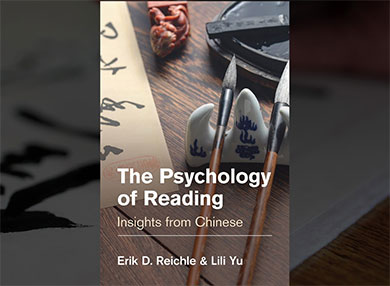What Chinese can teach us about the psychology of reading
A new book by Professor Erik Reichle and Dr Lili Yu from the School of Psychological Sciences looks at what has been learned about the developmental of skilled reading and dyslexia through a frame of one of the world’s most important – but under-studied – writing systems.
The Psychology of Reading: Insights from Chinese discusses what is known about the cognitive and neural processes that support the skilled reading of Chinese compared to English, and its development and impairment, and computer models that have been developed to understand these topics.
“Ninety-five per cent of the research done on reading relates to European languages and alphabetical scripts, and assumptions have been made that may not be universally true,” Professor Reichle says.
“In addition to this, much of the work on Chinese is written in Chinese, and as a native speaker, Dr Yu has been able to review this and make it accessible to a wider audience.
“What we have found certainly supports the theory that the study of other languages and writing systems that differ significantly from European languages has an important role to play.
“We believe the study of Chinese reading could help shape the science of reading in the future, and we hope this will highlight the need for and encourage more research in the area.”
Alphabet versus script
 While alphabetic languages like English have a limited number of characters and allow the reader to easily sound out unfamiliar words, Chinese readers must memorise more than 3,000 characters just to be able to read a newspaper, making learning the language to a high standard a complex and challenging process.
While alphabetic languages like English have a limited number of characters and allow the reader to easily sound out unfamiliar words, Chinese readers must memorise more than 3,000 characters just to be able to read a newspaper, making learning the language to a high standard a complex and challenging process.
Part of the literature Professor Reichle and Dr Yu reviewed includes studies of brain imaging performed while people are reading to analyse any differences in activity between alphabetic languages and Chinese.
Studies have shown the same brain networks and cortical regions are activated in skilled readers across languages and writing systems, but there are some marked differences when reading Chinese.
“The Chinese writing system accesses the brain’s visual centres and spatial memory, which makes sense because it is visually denser, and requires readers to process small components of the characters and the way they are set out and relate to each other,” Dr Yu says.
“In English, a reader can retrieve the sounds of letters directly, but with Chinese they have to take into account the pairing between the characters.
“One interesting finding from brain imaging studies is that when native English speakers learn Chinese, extra cortical regions are recruited on the right side of the brain, but when Chinese speakers learn English there are no changes.”
Written in an accessible style, the book will appeal to people with an interest in cognitive science, reading, language or education.
The Psychology of Reading: Insights from Chinese is published by Cambridge University Press on 18 January.
You can contact us about this story at communications@mq.edu.au.
Content owner: Faculty of Medicine, Health and Human Sciences Last updated: 08 Feb 2024 11:56am
